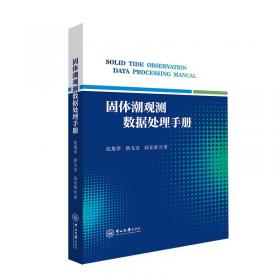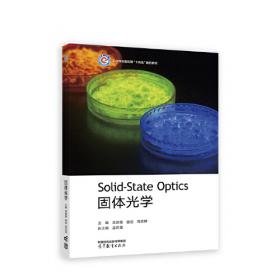固体物理学现代教程
出版时间:
2010-12
版次:
1
ISBN:
9787561158128
定价:
68.00
装帧:
平装
开本:
16开
纸张:
胶版纸
页数:
470页
字数:
940千字
-
SolidStatePhysicsisthestudyofthestateofsolids.Itsdevelopmentisaccompaniedbythedevelopmentofmodernscienceandtechnology.Itcontainsmanyfundamentalconceptsthatareessentialtoagreatnumberofbranchesofscience,includingthosewithinaswellasthoseoutsidephysics.Anexhaustedlistofthesebranchesisintimidating.Herewejustnameafew:Condensedmatterphysics,materialscience,semiconductorphysics,laserphysics,spin-tronics,physicaloptics,electricengineering,andelectronicengineering.Insolids,thereexistavarietyofparticles(includingquasiparticlesandelementaryexcitations)andinteractionsamongthem.Theseparticlesandinteractionsdeterminethepotentialapplicationsofvarioussolids.Forexample,thepeculiarbandstructureofelectronsinsemiconductorsleadtotransis-torsthataretheheartofeverythingelectronic;theelectron-photoninteractionsleadtolaserdiodes,photodiodes,andCCDs(coupledchargediodes);theelectron-phononinteractionsleadtopiezoelectricmaterials;theelectronspin-chargeinteractionsleadtospintronicsandquantumcomputation;themacroscopicquantumphenomenaofelectronsinmetallicsolidsleadtosuperconductivity,withthestrongcorrelationofelectronsleadingtohightemperaturesuperconductivity.Thus,itcanbesaidthatSolidStatePhysicsisthestudyoftheprop-ertiesofvariousparticlesinsolidsandtheinteractionsamongtheseparticlesaswellastheinteractionsoftheseparticleswithexternalfields.Electronsandnuclei(orvalenceelectronsandions)arethebasicconstituentsofsolids,withmanyotherquasiparticlesorelementaryexcitationsarisingduetotheinteractionsamongthemselvesorduetotheirinteractionswithexternalfields. 1drudetheoryofmetals
1.1drudemodelofametal
1.2basicassumptionsinthedrudetheory
1.3equationofmotion
1.4electricalconductivityofametal
1.5halleffectandmagnetoresistance
1.6thermalconductivityofametal
1.7inadequaciesofthedrudemodel
problems
2sommerfeldtheoryofmetals
2.1single-electronenergylevels
2.2groundstateoftheelectrongas
2.3finite-temperaturepropertiesoftheelectrongas
2.4conductionsinmetals
2.5inaccuraciesofthesommerfeldtheory
problems
3bravaislattice
3.1definitionofabravaislattice
3.2primitivevectors
3.3primitiveunitcell
3.4wigner-seitzcell
3.5conventionalunitcell
3.6latticevectors
3.7bravaislatticesintwodimensions
3.8bravaislatticesinthreedimensions
3.9mathematicaldescriptionofabravaislattice
problems
4pointgroups
4.1pointsymmetryoperations
4.2group
4.3pointgroupsforcrystalstructures
problems
5classificationofbravaislattices
5.1latticecenterings
5.2criteriaofclassificationofbravaislattices
5.3sevencrystalsystems
5.4crystallographicpointgroups
5.5summary
problems
6spacegroupsofcrystalstructures
6.1nonsymmorphicsymmetryoperations
6.2notationofaspacegroup
6.3symmorphicspacegroups
6.4nonsymmorphicspacegroups
6.5typicalcrystalstructures
problems
7scatteringofx-raysbyacrystal
7.1generaldescriptionofx-rayscattering
7.2scatteringofx-raysbyanatom
7.3scatteringofx-raysbyaprimitivecell
7.4scatteringofx-raysbyacrystal
problems
8reciprocallattice
8.1derivationofthereciprocallattice
8.2reciprocallatticesoftwo-dimensionalbravaislattices
8.3reciprocallatticesofthree-dimensionalbravaislattices
8.4brillouinzones
8.5reciprocallatticevectorsandlatticeplanes
8.6alternativedefinitionofmillerindices
8.7interplanardistancesinfamiliesoflatticeplanes
problems
9theoriesandexperimentsofx-raydiffraction
9.1characteristicx-raylines
9.2braggstheoryofx-raydiffraction
9.3vonlauestheoryofx-raydiffraction
9.4equivalenceofbraggsandvonlauestheories
9.5experimentalmethodsofx-raydiffraction
9.6diffractionbyapolyatomiccrystalwithabasis
problems
10crystalstructurebyneutrondiffraction
10.1neutrons
10.2elasticneutronscattering
10.3powderdiffraction
10.4pairdistributionfunctionanalysis
10.5neutronandx-raydiffraction
10.6rietveldprofilerefinement
problems
11bondinginsolids
11.1ionicbonds
11.2covalentbonds
11.3metallicbonds
11.4vanderwaalsbonds
11.5hydrogenbonds
11.6classificatiofiofcrystallinesolids
problems
12cohesionofsolids
12.1definitionofenergiesofcohesion
12.2cohesiveenergiesofmolecularcrystals
12.3latticeenergiesofioniccrystals
12.4cohesiveer/ergiesofalkalimetals
problems
13normalmodesoflatticevibrations
13.1born-oppenheimerapproximation
13.2latticepotentialenergyandharmonicapproximation
13.3normalmodesofaone-dimensionalcrystal
13.4normalmodesofaone-dimensionalioniccrystal
13.5normalmodesofa3dmonatomiccrystal
13.6normalmodesofa3dcrystalwithabasis
problems
14quantumtheoryoflatticevibrations
14.1classicaltheoryofthelatticespecificheat
14.2quantizationoflatticevibrations
14.3phonondensityofstates
14.4latticespecificheatofsolids
14.5debyemodel
14.6einsteinmodel
14.7effectofthermalexpansiononphononfrequencies
14.8specificheatofametal
problems
15inelasticneutronscatteringbyphonons
15.1experimentaltechniques
15.2descriptionofneutronscattering
15.3doubledifferentialcross-section
15.4elasticscattering
15.5inelasticscattering
15.6phonondispersionrelationsintetragonallacu204
problems
16originofelectronicenergybands
16.1blochstheorem
16.2periodic5-potentials
16.3schemesfordisplayingelectronicbandstructure
16.4free-electronbandstructures
16.5fermisurface
16.6densityofstatesinanenergyband
16.7electronicbandstructuresofrealsolids
16.8groupvelocityofanelectroninanenergyband
problems
17electronsinaweakperiodicpotential
17.1one-dimensionalweakperiodicpotential
17.2three-dimensionalweakperiodicpotential
problems
18methodsforbandstructurecomputations
18.1fundamentalprobleminanelectronicenergybandtheory
18.2hartree-fockmethod
18.3plane-wavemethod
18.4k·pmethod
18.5augmented-plane-wavemethod
18.6linearized-augmented-plane-wavemethod
18.7linear-muffin-tin-orbitalsmethod
18.8kkrmethod
18.9orthogonalized-plane-wavemethod
18.10tight-bindingmethod
problems
19dynamicsofblochelectronsinelectricfields
19.1velocityofanelectroninasingle-electronstate
19.2semiclassicalequationofmotion
19.3currentdensity
19.4holes
19.5blochoscillations
19.6wannier-blochandwannier-starkstates
problems
20fundamentalsofsemiconductors
20.1classificationofsemiconductors
20.2electronicbandstructuresofsemiconductors
20.3intrinsicsemiconductors
20.4hnpuritystates
20.5semiconductorstatistics
20.6electricalconductivityandmobility
20.7excitons
20.8carrierdiffusion
problems
index
physicalconstants
mathematicalconstantsandformulas
-
内容简介:
SolidStatePhysicsisthestudyofthestateofsolids.Itsdevelopmentisaccompaniedbythedevelopmentofmodernscienceandtechnology.Itcontainsmanyfundamentalconceptsthatareessentialtoagreatnumberofbranchesofscience,includingthosewithinaswellasthoseoutsidephysics.Anexhaustedlistofthesebranchesisintimidating.Herewejustnameafew:Condensedmatterphysics,materialscience,semiconductorphysics,laserphysics,spin-tronics,physicaloptics,electricengineering,andelectronicengineering.Insolids,thereexistavarietyofparticles(includingquasiparticlesandelementaryexcitations)andinteractionsamongthem.Theseparticlesandinteractionsdeterminethepotentialapplicationsofvarioussolids.Forexample,thepeculiarbandstructureofelectronsinsemiconductorsleadtotransis-torsthataretheheartofeverythingelectronic;theelectron-photoninteractionsleadtolaserdiodes,photodiodes,andCCDs(coupledchargediodes);theelectron-phononinteractionsleadtopiezoelectricmaterials;theelectronspin-chargeinteractionsleadtospintronicsandquantumcomputation;themacroscopicquantumphenomenaofelectronsinmetallicsolidsleadtosuperconductivity,withthestrongcorrelationofelectronsleadingtohightemperaturesuperconductivity.Thus,itcanbesaidthatSolidStatePhysicsisthestudyoftheprop-ertiesofvariousparticlesinsolidsandtheinteractionsamongtheseparticlesaswellastheinteractionsoftheseparticleswithexternalfields.Electronsandnuclei(orvalenceelectronsandions)arethebasicconstituentsofsolids,withmanyotherquasiparticlesorelementaryexcitationsarisingduetotheinteractionsamongthemselvesorduetotheirinteractionswithexternalfields.
-
目录:
1drudetheoryofmetals
1.1drudemodelofametal
1.2basicassumptionsinthedrudetheory
1.3equationofmotion
1.4electricalconductivityofametal
1.5halleffectandmagnetoresistance
1.6thermalconductivityofametal
1.7inadequaciesofthedrudemodel
problems
2sommerfeldtheoryofmetals
2.1single-electronenergylevels
2.2groundstateoftheelectrongas
2.3finite-temperaturepropertiesoftheelectrongas
2.4conductionsinmetals
2.5inaccuraciesofthesommerfeldtheory
problems
3bravaislattice
3.1definitionofabravaislattice
3.2primitivevectors
3.3primitiveunitcell
3.4wigner-seitzcell
3.5conventionalunitcell
3.6latticevectors
3.7bravaislatticesintwodimensions
3.8bravaislatticesinthreedimensions
3.9mathematicaldescriptionofabravaislattice
problems
4pointgroups
4.1pointsymmetryoperations
4.2group
4.3pointgroupsforcrystalstructures
problems
5classificationofbravaislattices
5.1latticecenterings
5.2criteriaofclassificationofbravaislattices
5.3sevencrystalsystems
5.4crystallographicpointgroups
5.5summary
problems
6spacegroupsofcrystalstructures
6.1nonsymmorphicsymmetryoperations
6.2notationofaspacegroup
6.3symmorphicspacegroups
6.4nonsymmorphicspacegroups
6.5typicalcrystalstructures
problems
7scatteringofx-raysbyacrystal
7.1generaldescriptionofx-rayscattering
7.2scatteringofx-raysbyanatom
7.3scatteringofx-raysbyaprimitivecell
7.4scatteringofx-raysbyacrystal
problems
8reciprocallattice
8.1derivationofthereciprocallattice
8.2reciprocallatticesoftwo-dimensionalbravaislattices
8.3reciprocallatticesofthree-dimensionalbravaislattices
8.4brillouinzones
8.5reciprocallatticevectorsandlatticeplanes
8.6alternativedefinitionofmillerindices
8.7interplanardistancesinfamiliesoflatticeplanes
problems
9theoriesandexperimentsofx-raydiffraction
9.1characteristicx-raylines
9.2braggstheoryofx-raydiffraction
9.3vonlauestheoryofx-raydiffraction
9.4equivalenceofbraggsandvonlauestheories
9.5experimentalmethodsofx-raydiffraction
9.6diffractionbyapolyatomiccrystalwithabasis
problems
10crystalstructurebyneutrondiffraction
10.1neutrons
10.2elasticneutronscattering
10.3powderdiffraction
10.4pairdistributionfunctionanalysis
10.5neutronandx-raydiffraction
10.6rietveldprofilerefinement
problems
11bondinginsolids
11.1ionicbonds
11.2covalentbonds
11.3metallicbonds
11.4vanderwaalsbonds
11.5hydrogenbonds
11.6classificatiofiofcrystallinesolids
problems
12cohesionofsolids
12.1definitionofenergiesofcohesion
12.2cohesiveenergiesofmolecularcrystals
12.3latticeenergiesofioniccrystals
12.4cohesiveer/ergiesofalkalimetals
problems
13normalmodesoflatticevibrations
13.1born-oppenheimerapproximation
13.2latticepotentialenergyandharmonicapproximation
13.3normalmodesofaone-dimensionalcrystal
13.4normalmodesofaone-dimensionalioniccrystal
13.5normalmodesofa3dmonatomiccrystal
13.6normalmodesofa3dcrystalwithabasis
problems
14quantumtheoryoflatticevibrations
14.1classicaltheoryofthelatticespecificheat
14.2quantizationoflatticevibrations
14.3phonondensityofstates
14.4latticespecificheatofsolids
14.5debyemodel
14.6einsteinmodel
14.7effectofthermalexpansiononphononfrequencies
14.8specificheatofametal
problems
15inelasticneutronscatteringbyphonons
15.1experimentaltechniques
15.2descriptionofneutronscattering
15.3doubledifferentialcross-section
15.4elasticscattering
15.5inelasticscattering
15.6phonondispersionrelationsintetragonallacu204
problems
16originofelectronicenergybands
16.1blochstheorem
16.2periodic5-potentials
16.3schemesfordisplayingelectronicbandstructure
16.4free-electronbandstructures
16.5fermisurface
16.6densityofstatesinanenergyband
16.7electronicbandstructuresofrealsolids
16.8groupvelocityofanelectroninanenergyband
problems
17electronsinaweakperiodicpotential
17.1one-dimensionalweakperiodicpotential
17.2three-dimensionalweakperiodicpotential
problems
18methodsforbandstructurecomputations
18.1fundamentalprobleminanelectronicenergybandtheory
18.2hartree-fockmethod
18.3plane-wavemethod
18.4k·pmethod
18.5augmented-plane-wavemethod
18.6linearized-augmented-plane-wavemethod
18.7linear-muffin-tin-orbitalsmethod
18.8kkrmethod
18.9orthogonalized-plane-wavemethod
18.10tight-bindingmethod
problems
19dynamicsofblochelectronsinelectricfields
19.1velocityofanelectroninasingle-electronstate
19.2semiclassicalequationofmotion
19.3currentdensity
19.4holes
19.5blochoscillations
19.6wannier-blochandwannier-starkstates
problems
20fundamentalsofsemiconductors
20.1classificationofsemiconductors
20.2electronicbandstructuresofsemiconductors
20.3intrinsicsemiconductors
20.4hnpuritystates
20.5semiconductorstatistics
20.6electricalconductivityandmobility
20.7excitons
20.8carrierdiffusion
problems
index
physicalconstants
mathematicalconstantsandformulas
查看详情
-
八五品
北京市朝阳区
平均发货13小时
成功完成率85.37%
-
八五品
重庆市南岸区
平均发货18小时
成功完成率85.8%
-
八五品
重庆市沙坪坝区
平均发货8小时
成功完成率84.16%
-
八五品
山东省滨州市
平均发货9小时
成功完成率93.84%
-
八五品
四川省成都市
平均发货8小时
成功完成率81.14%
-
固体物理学现代教程
正版二手,均有笔记不影响使用,无赠品、光盘、MP3等。如需购买套装书,请联系客服核实,批量上传数据有误差,套装书售后运费自理,还请见谅!
八五品
山东省枣庄市
平均发货8小时
成功完成率88.91%
-
固体物理学现代教程
正版二手书,图片套装请联系客服再下单,均有笔记不影响使用,无赠品、光盘、MP149603等
八五品
山东省枣庄市
平均发货9小时
成功完成率87.92%
-
八五品
山东省济南市
平均发货8小时
成功完成率94.28%

 占位居中
占位居中





















